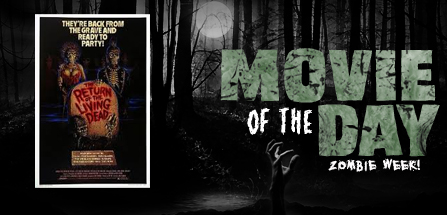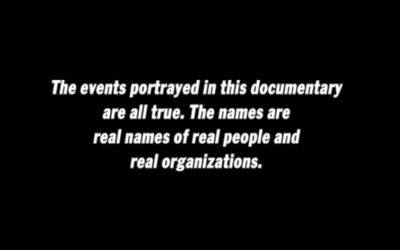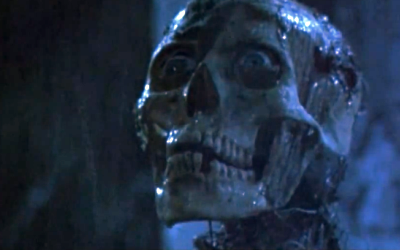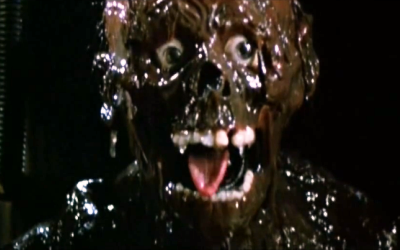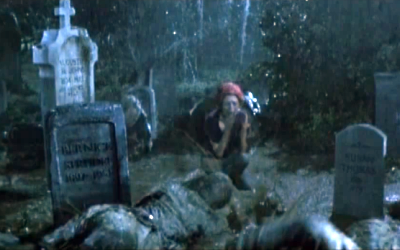The Film: The Return of the Living Dead (1985)
The Principles: Dan O’Bannon (director), Clu Gulager, James Karen, Don Calfa, Thom Mathews, Linnea Quigley
The Premise: A zomedy that mixes the proper amount of comedy in with it’s terrifying, rule breaking zombies.
Is It Any Good: Better than it has any right to be. Return of the Living Dead took on a genre that had defined rules created by the oft credited George A. Romero. Sure, you can come up with 50 references of zombies before Romero, but he created the flesh eating zombies that mainstream audiences recognize on sight. Romero and most works before Romero played on an intelligent playground that constrained the zombies to either socio-political agendas or as failed science with the sympathy being on the revitalized dead. Return of the Living Dead introduced zombies that had no redeeming grace, but they had a show of intelligence that mirrored Romero’s Day of the Dead, released in the same year. These zombies knew what they wanted, and even spoke clearly. Bub, the test tube zombie in Romero’s story was barely capable of slopping syllables together to make a noise that could be interpreted as speech.
Just as with the Romero films, the budget for Return of the Living Dead was low, so they used lesser known actors and went for broke with the effects. First time director Dan O’Bannon had previously worked on lower budget films with the likes of John Carpenter (Dark Star) and Ridley Scott (Alien), so even though he was new to being the captain of the ship, he had been on some ships with some great captains. That is the only thing I can think of that turned his little funny zombie movie into something that many people refer to as one of the best zombie movies ever made.
It takes no time to establish that this film is not going to follow the path other zombie films have taken, as it flashes a public service. “The events portrayed in this film are all true. The names are real names of real people and real organizations.” This spin on the introductions to Last House on the Left, Texas Chainsaw Massacre and Picnic at Hanging Rock served as a basis to separate it from what had come before. No longer the based loosely on events, and figuring that no one had ever heard of an entire town being wiped out, the comedic twist appeared (though as an 11 year who watched this, it left enough of a question that made it hard to sleep that night).
The tone of the movie is the often attempted but rarely successful blend of horror and comedy. This begins at the concept level, which by most standards should fail in a horror film because of the absurd humor. The first implausible concept is an entire warehouse full of split dogs and cadavers, and that it is not secured in the slightest way makes for such fun redneck humor. The transition of the two workers from dork to dead, along with the paramedics that are called to help is one of the best long running jokes in the film. The last is a play of the cliques of friends in the 80s, where an outcast good girl heroine is mixed up with a group of punks without any explanation as to how the hell they are friends, let alone the dialogue between them.
The zombies also broke barriers. These zombies were capable of full speech, and comprehension. Romero had played with the fact that we are actually zombies in our routine lives, where O’Bannan (based on concepts by Romero’s original creative partner, John Russo) took away the social commentary from the zombies and replaced it with cunning. Unexplained cravings for brains took the normal weakness of the zombie definition and turned it into their driving factor. They didn’t continue the routine they had when they were alive, they were out to ensure their pain in the afterlife was soothed by consuming cerebral tissue from the living. They knew they would kill, but they just didn’t care. It appears the afterlife makes us all into sociopaths.
O’Bannon may have also unwittingly been the first person to make a zombie film where the zombies didn’t crawl after their victims. These things were fast. I saw one do an open field tackle better than half the linebackers in the NFL. Though the zombies don’t actually receive a lot of screen time, they capitalize on what they get. They didn’t need large numbers to trap the victims as they would lie in wait, let the victims make themselves vulnerable by leaving their protection, and then pounce. They were like most of the real world apex predators. Attacking the unsuspecting victim before they even had a chance to fight back is the greatest way to secure their fresh meal.
The other crazy thing about these zombies is they didn’t need anything to keep going. Severed limbs still moved after separation, heads still tried to eat without a body and best of all were the skeletons who were not only hungry but also able to say the catch phrase “Brains”.
The special effects, though very noticeable under scrutiny, look great at first glance. Some hold up well past a glance, but some had minimal screen time for known reasons. The canister corpse, played by one of the Henson puppeteers, steals every second of screen time he is in and his muttering of “Brains” has been both mimicked and parodied ever since. The split dogs were not only an entertaining concept but a complete success for the animatronics team. The talking corpse on the table in the morgue also withstood the bright lights and close up footage. What gets effectively pushed to the back are almost all of the mob scenes. Many of which the extras barely resemble zombies, and strike in such a fast series of events that focuses the attention on the action and not the effects. This maintains the feel of a much higher production value than the actual budget made possible.
Is It Worth A Look: For the fully naked Linnea Quigley alone. She’s not the only genre actor here either. Clu Gulager, from Feast and HBO’s Project Greenlight plays Burt and a great character actor that most people have seen 50 times at least, Don Calfa (Barney Miller, Star Chamber, Bugsy) plays Ernie. The two names have their own little in-joke though O’Bannon says that was never the intention.
Thom Mathews will be remembered for not only this genre classic but also as the reemergence of Tommy Jarvis in Friday the 13th Part 6: Jason Lives.
The main cast is truly divided into the younger punks and the older workers, with only Thom Mathews being caught between the two groups. Only one member of the cast returns as a zombie, the still fully nude Quigley, and the army is led by a retirement age officer and the work he has done for him is by young grunts. This may sound very typical, but it dramatically appealed to the punk crowd at the time of release. The music was mostly punk influenced with the clothing and hair styles of the youth to match.
Random Anecdotes:
Tobe Hooper was originally tied to direct with a John Russo script. Hooper bailed to film O’Bannon’s Lifeforce script, and O’Bannon was brought in, but only on the condition that he be able to change the script.
Both warehouse workers were originally slated to hunt the victims after turning into zombies. James Karen had not wanted to film in makeup under the L.A. rain, so he approached O’Bannon with the suggestion that his character cremate himself.
Cinematic Soul Mates: Night of the Living Dead, Zombieland, Day of the Dead, Shaun of the Dead, Return of the Living Dead 2, Zombie 2
